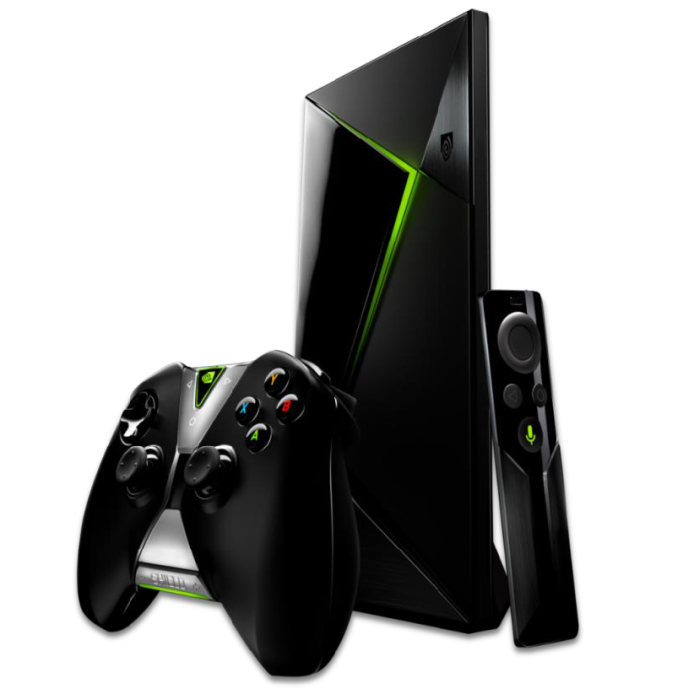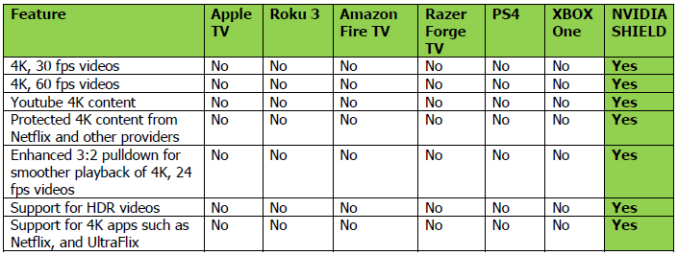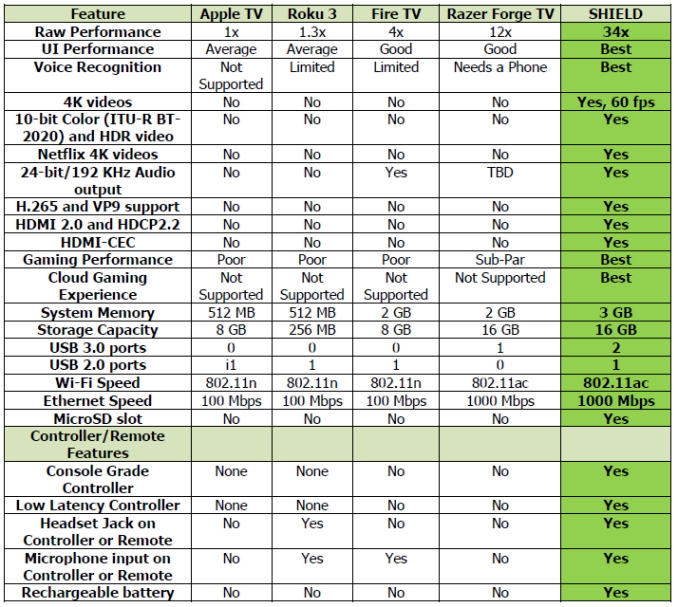The NVIDIA SHIELD Android TV Review: A Premium 4K Set Top Box
by Ganesh T S on May 28, 2015 3:00 PM EST- Posted in
- Media Streamer
- Home Theater
- TV
- 4K
- Shield
- NVIDIA

The battle for the living room (i.e, controlling the television experience) is heating up with forays from multiple vendors. As the cord-cutting trend gains momentum, the time seems to be right for disruption. Roku has been around for a long time and they continue to taste success with inexpensive and small over-the-top set-top boxes (OTT STBs). At the other end of the spectrum is the Apple TV, which, despite just being a 'hobby', has managed to move millions of units. Google had tried to make inroads into this market a few years back with the Google TV / Logitech Revue, but, it unfortunately didn't pan out as expected. Chromecast turned out to be more popular in their second attempt, but it was a limited play. In late 2014, Google launched Android TV along with the Nexus Player.
Coinciding with Google I/O, NVIDIA is releasing their previously announced SHIELD Android TV. First announed back in March at the 2015 Game Developers Conference, SHIELD Android TV is a premium 4K-capable over-the-top set-top box (OTT STB) with a powerful graphics engine. The differentiating aspects compared to the Intel Bay Trail-based Nexus Player and the Qualcomm Snapdragon-based Razer Forge TV lie in 4K support (HDMI 2.0 / HDCP 2.2 / Netflix 4K-certification) and excellent gaming credentials.
| NVIDIA SHIELD Family | ||
| NVIDIA SHIELD Tablet | NVIDIA SHIELD Android TV | |
| SoC | Tegra K1 (2.2 GHz 4x Cortex A15r3, Kepler 1 SMX GPU) | Tegra X1 (4x Cortex A57 + 4x Cortex A53, Maxwell 2 SMM GPU) |
| RAM | 2 GB LPDDR3-1866 | 3 GB LPDDR4-3200 |
| NAND | 16/32GB NAND + microSD | 16GB NAND + microSD + USB |
| Display | 8” 1920x1200 IPS LCD | N/A, HDMI 2.0 4Kp60 Output |
| Dimensions | 221 x 126 x 9.2mm, 390 grams | 210 x 130 x 25mm, 654 grams |
| Camera | 5MP rear camera, 1.4 µm pixels, 1/4" CMOS size. 5MP FFC | N/A |
| Battery | 5197 mAh, 3.8V chemistry (19.75 Whr) | N/A, 40W Power Adapter |
| OS | Android 5.0.1 | Android TV |
| Connectivity | 2x2 802.11a/b/g/n + BT 4.0, USB2.0, GPS/GLONASS, mini HDMI 1.4a | 2x2 802.11a/b/g/n/ac + BT 4.1/BLE, USB 3.0 + 2.0, HDMI 2.0 + HDCP 2.2, IR Receiver, Gigabit Ethernet |
| Launch Price | $299 (16GB/WiFi) + $59 (optional controller) | Basic: $199, Includes 1 SHIELD Controller Pro: $299, Adds 500GB Hard Drive |
The NVIDIA SHIELD smart TV platform comprises of three distinct products, the SHIELD console, the SHIELD wireless controller and the SHIELD remote.
The SHIELD is the main console, integrating a Tegra X1 SoC along with 3 GB of LPDDR4 DRAM and 16 GB of storage. I/O ports include two full-sized USB 3.0 host ports, a USB 2.0 micro-USB device port, GbE RJ-45 port, IR for universal remotes and 802.11ac 2x2 MIMO Wi-Fi with Bluetooth 2.1. It also includes a microSDXC slot. Video output is handled by a HDMI 2.0 port with HDCP 2.2 support.
The SHIELD Wireless Controller is the game controller bundled with the SHIELD console, and was first launched last year with the SHIELD Tablet. It uses Wi-Fi Direct for communication. A stereo headset jack and microphone are integrated. It also includes a rechargeable battery that can provide up to 40 hours of battery life.
Finally, the SHIELD Remote It is meant to be a replacement for the game controller in situations where single-handed operation is preferable. It uses Bluetooth for communication with the console. Like the game controller, a microphone and headset jack are included. The rechargeable battery is good for up to 4 weeks.
While the game controller and the console together retail in the basic package for $199, the SHIELD Remote is available separately for $50. Meanwhile after a slight snafu where it was announced back in April and then immediately pulled, NVIDIA is indeed offering a higher-end Pro SKU. SHIELD Pro model is similar to the SHIELD described above, except it adds an internal 500 GB hard drive into the mix and bundles a game - Borderlands: The Pre-Sequel! The Pro model is priced at $299.
Prior to diving into the details, let us take a look at the devices that NVIDIA is positioning the SHIELD Android TV against. Note that the two tables below are direct from NVIDIA's marketing material.
As we will see further down in the review, the above table is not far from the truth. In fact, except for NVIDIA claiming that their pulldown algorithm is enhanced compared to the competition, we tend to agree with everything. For the moment at least, NVIDIA pretty much has the 4K set top box to themselves.
NVIDIA claims a 34x raw performance increase compared to other OTT STB platforms. We won't endorse that particular number, but, in general, the performance of the SHIELD is miles ahead of the competition. The only other entry we find contentious is the availability of 24-bit / 192 KHz audio output. As we will see in the local media playback evaluation section, this is something of a moot point in most scenarios since the unit doesn't have licenses for decoding lossless HD audio. In any case, the above tables give an idea of where NVIDIA is positioning the SHIELD Android TV in the market.
The NVIDIA SHIELD Android TV also happens to be the first shipping product with the Tegra X1 SoC. We will first analyze the SoC and its performance in detail before moving on to Android TV in general and the SHIELD in particular.













167 Comments
View All Comments
ES_Revenge - Wednesday, June 10, 2015 - link
Perhaps not but Tegra X1 might be Maxwell but it's only 256:16:16 with 512 GFLOP SP performance. That in the realm of a GT 730...and the GDDR3 730 is faster than that, lol. In AMD-speak that's around equal to an R7 240.PS4 OTOH is a little below an R9 270 (around a GTX 660) and has over 1800 GFLOP SP performance. "On paper" it's already about 4x faster computationally, and it has about 7x the VRAM bandwidth.
Trying to compare a 7850/R9 270/GTX 660 to an R7 240/GT 730 is lulz though and it's very hard to find any kind of direct comparison between the two because they're never tested together and low end cards are typically tested at lower res and settings than higher end ones. It may not be actually an order of magnitude difference quantitatively but that's not really here nor there in the real world. In 1080p, we're talking about the difference between 10-15 FPS (i.e. totally unplayable) to 30-50 FPS (not spectacular but still very playable), between the two. The qualitative difference between 10FPS and 30FPS is HUGE so it seems like "an order of magnitude" in realith.
Nevermind the CPU side is well behind the 4M/8T Jaguar x86 CPU in the PS4.
MJJackson - Saturday, June 29, 2019 - link
Isso que eu chamo de bíblia hein. Como você teve disposição para escrever tudo isso? E como este site suporta tantos caracteres em um comentário?MJJackson - Saturday, June 29, 2019 - link
Isso que eu chamo de bíblia hein. Como você teve disposição para escrever tudo isso? E como este site suporta tantos caracteres em um comentário?Samus - Friday, May 29, 2015 - link
So this is a $200-$300 Roku on steroids?Udo - Tuesday, June 2, 2015 - link
No, on gamma radiation.ToTTenTranz - Friday, May 29, 2015 - link
And it'll do jack for selling Tegra devices because:1 - Such games have been in the PC for years or even a decade. Whoever wants to play them, can do it on a PC.
2 - Being greedy and making these games exclusive to Tegra devices/consoles means they won't ever enlarge the market for higher-end games on Android, which in turn won't ever raise the demand for higher-performing Android devices (like Tegra X1).
mkozakewich - Saturday, May 30, 2015 - link
People are replacing their computers with tablets and things, so I could imagine someone junking their six-year-old computer and getting this, and just getting a large phone for any mobility needs.I personally don't have any of the latest consoles or a new TV; so if I was going to get one right now, I'd try to get a 4K TV and this console would be really tempting.
smorebuds - Thursday, May 28, 2015 - link
Nintendo should come out with an Android-based console. And start making mobile games that can scale up to tv size. And let us play touch optimized pokemon on our phones dammit.testbug00 - Thursday, May 28, 2015 - link
Why android? They have ARM consoles, they know to do touch. Going android just makes it easier for other android users to get Nintendo games pirated...tipoo - Thursday, May 28, 2015 - link
Their own operating systems all being slow as molasses could be a reason, though that could also be down to the hardware.